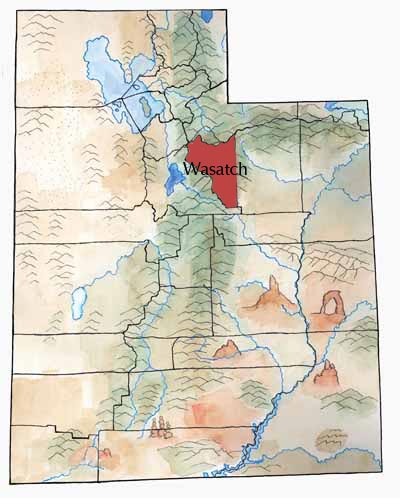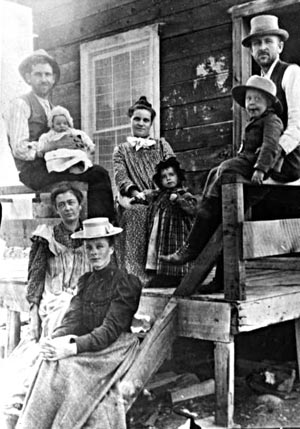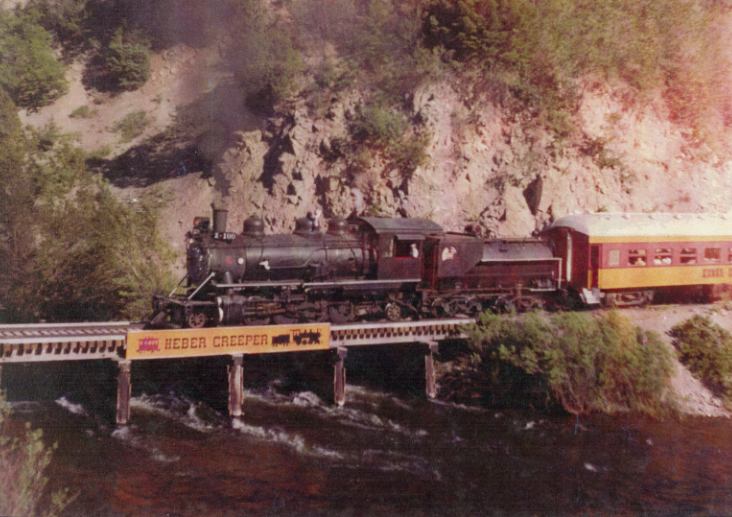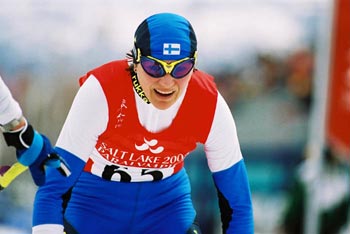Utah’s Switzerland—that’s what people call this place! Why? Because of the rugged beauty of Mount Timpanogos overlooking Heber Valley, the green meadows, the streams, the cool climate, and the large population of Swiss people who settled in Midway in the 1800s.

The county’s highest peaks top 10,000 feet, and more than half the land is 7,500 feet above sea level. The high mountain valleys experience cool summers and very cold winters.
Because the county lies between the Wasatch and Uinta mountains, a lot of rain and snow fall here—an average of 16 inches of precipitation annually. The county’s streams flow either into the Great Basin or into the Uinta Basin, eventually heading to the Colorado River.
Water also flows into the county through two man-made sources. The Ontario Drain Tunnel drains water from many Park City mines into the Keetley area. And the Weber/Provo diversion canal (built in 1930) diverts water from the Weber River in Summit County and brings it to the Provo River in Wasatch County.

First Peoples
Scholars don’t know much about the First Peoples of Wasatch County. A few small sites and artifacts have been found. No Fremont or Ute sites have been found—though no doubt they hunted and fished here.
The Ute guide for Dominguez and Escalante told them that a group of Lagunas (Utah Lake Utes) had lived in the valley, fishing in the river, but out of fear of Comanches they had abandoned the valley.
History
Fur trappers, including Etienne Provost from Taos, New Mexico, and William H. Ashley and members of his company from St. Louis, Missouri, passed through the area in the 1820s and 1830s.

Settlers
The first Euro American settlers came into Wasatch County from Utah Valley in the spring of 1859. They built homes a little bit north of present Heber City. That same year, settlers also moved to the Midway and Charleston areas.
In 1862 the territorial legislature created Wasatch County, which then included the entire Uinta Basin. (“Wasatch” in Ute may mean “mountain pass” or “low pass over high range.”) Heber City, named for Mormon apostle Heber C. Kimball, became the county seat.
Over the years, many Wasatch citizens worked in the mines at Park City, sometimes as strikebreakers. Others sold hay and other agricultural goods to Park City.
Mostly people worked in agriculture, producing hay, dairy products, sheep, and cattle.
Developments
When the Denver and Rio Grande Railroad completed a line into the county from Provo in 1904, country residents were happy. They could send mail, ship wool and other farm products, and receive visitors much more easily.

In 1922 the Union Pacific Railroad built a spur from Park City to the mines west of Keetley and began shipping lead, zinc, and silver ore. Today, the only train that runs to Wasatch County is the “Heber Creeper,” a recreational train. Other economic activities are more important to the county than transportation and mining.
Around the turn of the 19th century, people in Utah Valley began to push for a reservoir to provide them more water. They got it, with the construction of Strawberry Reservoir. But that reservoir took away lands from the Ute reservation, and it covered lands livestock owners in Wasatch County had been using for grazing.
Similarly, Deer Creek Reservoir (completed in 1941) and Jordanelle Reservoir (completed in 1992) forced people to leave their homes, their lands, and their livelihoods. They did this in order to provide more water for people on the Wasatch Front.
Recreation
The “hot pots” in Midway have long given residents a place to relax. The original resort, Schneiter’s Hot Pots, is now the Homestead.

In the 1960s, a group of people worked hard to create a new state park. They pressured the state and landowners, who eventually felt forced to sell and had to give up their livelihood. The state paid $600 per acre for farmland and $30 per acre for rangeland, and from that land the state created Wasatch Mountain State Park.
The three reservoirs, together with sparkling streams and beautiful mountain scenery, have made Wasatch County a popular recreation area.
Many great historic buildings in Heber City and Midway have been preserved.
The county provides excellent opportunities for fishing, boating, and other summer and winter outdoor activities. Increasingly, Heber Valley has become a “bedroom community” for many people who work in Utah Valley, Park City, and Salt Lake City.
Did You Know?
| Heber City once had a pea factory, canning the peas farmers grew. In 1920, it produced 60,000 cases. |
| In 1908 Heber tried to eliminate liquor drinking by passing a city prohibition ordinance that outlawed saloons. |
| Soldier Summit at the top of Spanish Fork Canyon was once a little railroad town with businesses, homes, school, and church. |
| A group of Japanese Americans settled east of Park City (at Keetley Junction) during World War II and grew vegetables. |
| Many great historic buildings in Heber City and Midway have been preserved. |
Fast Facts
Area: 1,191 Square Miles
County Seat: Heber City
Where it Got its Name: Wasatch Mountain Range
Main Cities/Towns: Heber City: Midway
Economy: Hay, Livestock, Recreation
Keep Exploring
Return to the County’s home page here.
Return to the I Love Utah History home page here.